Before the 1990s, the era when the power centers of fashion began to be much more numerous and dispersed, decades could be easily identified by the most prominent looks and cuts of their pervasive styles. The closet of the sixties in no way resembled the closet of the seventies; the clothing of the seventies was considered so outré it would practically get you beaten up in the eighties. Style was a singular and perishable flowering every ten years, and movies offered a fabulous glimpse at the aesthetic gardens of their time.
The seventies were a thrillingly specific period for new fashion due to the immense amount of social change that spilled over from the late sixties, which brought about widespread generational mistrust of authority, the antiwar movement, and the advent of psychedelia. Counterculture clothing was migrating—it became present not only at anti-establishment hippie rock concerts and on goat-farm communes but also among regular people, assimilated into the mainstream workforce.
The sexual revolution was still test-driving; there was considerably more nudity on-screen in the 1970s than there is today. Newly liberated women cast off their fifties-throwback, movement-restricting stiletto heels and pencil skirts, and were suddenly allowed to stride around in chunky-heeled boots and wide palazzo pants (before they ended up on the shag carpet). Nearly everyone looked somewhat bohemian, or at least boho-adjacent.
Fashionable men’s hair, even in corporate settings, seemed to settle somewhere between the neck and the ears (unless you were in law enforcement). Women abandoned the hard, high sculptural hairstyles of the sixties—a look of tight social control—in favor of long, natural hair flips of liberation that seemed to mimic the vestigial fins that shrank from the tails of Detroit sedans.
Styles were so articulate then that it is possible for anyone with a sharp eye for fashion history to pinpoint the exact year that a film was made, based solely on the trends featured in them. Each of the movies in the Criterion Channel’s ’70s Style Icons series interprets its moment, with particular attention paid to the influence of locations (East Coast and West Coast styles, for example, were markedly different) and the socioeconomic standing of characters. Together these glorious artifacts chart the subtle but unmistakable changes that unfolded over this flashy, florid decade.
Performance (1970)
Directed by Donald Cammell and Nicolas Roeg
Costume consultant: Deborah Dixon
Wardrobe by Billy Jay and Emma Porteous
The oldest film in the series happens to be one of the most sartorially radical. Nicolas Roeg’s London-set Performance is cast with the faces of the era’s rock-and-roll demimonde. It’s a priceless time capsule of the absolute cutting edge of the fashion avant-garde in 1970.
Arguably the most beautiful woman in the world at that moment—seventies it-girl and Rolling Stones muse Anita Pallenberg—drapes around Mick Jagger’s hiply Marrakech-opium-den-style apartment, mostly naked under fox furs and satiny frocks. James Fox is a Dapper Dan gangster on the lam in Saville Row tailoring, and Mick Jagger has a proto-goth appearance like he’s auditioning to be the lead singer of Jane’s Addiction.
A fabulous fashion transformation takes place in which Fox’s gangster persona is deconstructed and Mick Jagger and La Pallenberg disguise him as a Jimi Hendrix type, replete with fright-wig, pirate blouse, and tapestry jacket. Changing clothes, at least in the seventies for Nicolas Roeg, was changing your persona.
Shaft (1971)
Directed by Gordon Parks
Costumes by Joe Aulisi
While you might think a blaxploitation film would feature some of the more outrageous offerings of 1970s apparel, the impeccable gentlemen of Shaft don’t dress in groovy costume so much as employ the chic and aristocratic looks you’d associate with Dick Cavett and young BBC executives. Richard Roundtree is lustrously turned out in cashmere turtlenecks and leather trench coats. His enemies wear gorgeously cut 1940s-style gangster attire and the finest Italian suiting, with French cuffs and gold cufflinks. Virtually every outfit in Shaft, if worn today (even with the longer seventies hair length), could command attention in any room. Leave it to Gordon Parks to masterfully pair of-the-moment hipness with such timeless elegance, even in a potentially hazardous fashion year like 1971, when collars and pant-legs were allowed to grow to enormous sizes. Parks understood the enduring power of Italian leathers and superior wools.
Klute (1971)
Directed by Alan J. Pakula
Costumes by Ann Roth
Klute has a killer screenplay, but the movie is really all about Fonda’s exceptionally great, Oscar-winning star turn as the multifaceted call girl Bree Daniels, who wears miniskirts, tight knit shirts (no bra), and a forward-combed, just-rolled-out-of-bed shag hairstyle. She’s a hooker who finds her confidence in turning tricks and her humiliation in being an actress and model.
Seventies fashion is at its apex in Klute’s hipster bars, which are decorated in tapestry curtains, damask wallpaper, and peacock feathers. Winsomely thin ladies with protruding hip bones, dressed in Pucci-style prints and big, beaded chokers, silky headscarves, and gypsy hoop earrings, lounge like Siamese cats on Eero Saarinan–designed Tulip chairs.
Hats in Klute are floppy, zippers have pull-rings, and eyebrows are rarely made of actual hair.
All of Ms. Fonda’s brassy, self-assured sexiness ends up in a battle of wills against Donald Sutherland’s square private detective, with his beige station wagon and ironed pajamas—and the shortest haircut of the actor’s career. It is unclear who is the real victor in the end. As Bree says: “When you’re used to being lonely and somebody comes in and moves that around, it’s kind of scary I guess.”
What’s Up, Doc? (1972)
Directed by Peter Bogdanovich
Costumes by Polly Platt (uncredited)
Barbra Streisand is at her most whimsically adorable and fetching in this slapstick gem scripted by Buck Henry. She has a gamine, young-Jennifer-Aniston quality, with her well-tanned skin, long ironed hair, flared slacks, wide-collared button-up shirts, and paperboy hats. Ryan O’Neal plays her nerd-scientist love interest in plaid Jerry Lewis bowties, and Madeline Kahn steals the show as his henpecking dud of a high-minded fiancée in an array of frightening double-knit housecoats with large daisy prints. The whole movie is as bright and fun as the wallpaper in Rowan & Martin’s late-sixties/early-seventies sketch comedy show Laugh-In.
Foxy Brown (1974)
Directed by Jack Hill
Wardrobe for Pam Grier by Ruthie West
If seventies blaxploitation films did anything positive for the black community, they at least captured a fantastic era of street fashion—and 1974 was a year when clothing seemed cut to deliberately complement the cars coming out at the time. Long, strong, and bright two-door Detroit V8 coupes were a perfect accessory to large afros, giant sunglasses, tight flare-legged pants and silky prints, wide-collar shirt and satin blouses.
Nothing is a purer statement of the decade than its oversexed fashions. Fortunately for this film, the exquisitely beautiful Pam Grier—who has one of the greatest bodies in cinema history—must go undercover as a call girl. While the villainous madame bedecks herself in oversize owl pendants, Foxy launches a thousand ships in a revealing halter pantsuit the lavish vermillion of begonias. That moment is equal to Rita Hayworth flipping her hair in Gilda.
Shampoo (1975)
Directed by Hal Ashby
Costumes by Anthea Sylbert
Of all of the movies to come out of the midseventies, Shampoo arguably screams “SEVENTIES FASHION!” louder than any other. Perhaps that’s because of the world its lead character—a Beverly Hills hairdresser (Warren Beatty) who pathologically womanizes his elite clientele—occupies: that of rich women in long pearls and 450SL Mercedes.
Beatty is perfect as a poncy, motorcycle-riding party boy in collarless white tunic shirts, rash French-poet hair, tight jeans, swinging necklaces, and turquoise-encrusted concha belts, navigating a hazardous terrain of ficus trees, highlighted tips, and frosty white fingernails.
The women of Shampoo epitomize midseventies style, particularly Julie Christie in dusty lavender ensembles (and what became a truly iconic haircut), and the infantilized if delectable Goldie Hawn in velour minidresses, rose-colored glasses, and tiny floral panties.
A hilarious fashion standoff happens between Nixon supporters and the infiltrating Laurel Canyon hippies. Beatty, in his velvet tuxedo and ruffly shirts has no problem out-sexying the staid, wealthy establishment of Beverly Hills in a look that must have been Mike Myers’s inspiration for Austin Powers.
A Star Is Born (1976)
Directed by Frank Pierson
Costumes by Seth Banks and Shirlee Strahm
This is a flawed film but an interesting one, particularly when viewed alongside What’s Up, Doc?, in which Barbra Streisand was not yet in control of her industrial complex. This movie was the project of a Barbra who was going for total control of her own image, and bending it in a drastic new direction.
Scarlett Newman in Garage magazine wrote: “Before the film was even made, Streisand’s then-boyfriend (and former hairdresser, who would also serve as a producer on the film) Jon Peters was supervising an effort to reshape her look. Babs was suddenly very blonde, very tan, very sexy, and very Hollywood. The new Babs was rocking skin-tight denim and hot pants and going braless.”
Ms. Streisand’s frizzy coif is paired with a puzzlingly expensive-looking array of very tailored, very Upper-East-Side, Bonwit Teller–style pantsuits and Diana-Ross-esque pharaonic gold stage ensembles. For an up-and-coming club musician, her style remains oddly consistent throughout the film, and it does so even after she attains world superstardom and unspeakable fortune by upstaging her alcoholic husband (Kris Kristofferson). This mystery is finally explained by one of the more thrilling costume credits in film history: “Ms. Streisand’s clothes from . . . her closet.”
Barbra definitely should have won an award for possessing the best manicure ever seen in film—or perhaps even human—history.
The Man Who Fell to Earth (1976)
Directed by Nicolas Roeg
Costumes by May Routh
David Bowie plays a highly sensitive alien subject to manias triggered by the cacophony of modern life. The film suggests that we all are “alienated”—fatigued from technology overload and the speed of innovation.
Against a setting of seventies bureaucratic dullness—root-beer-colored sedans; plaid couches and sport-coats; wide, dark brown neckties; dark wood paneling and burgundy Naugahyde restaurant booths—Bowie appears to have fallen from space by way of Carnaby Street and/or the lost wardrobe of Brian Jones.
The alien provides a shock of the new in feminine cut suits (made by Ola Hudson), wide-brimmed velvet fedoras, high-waisted gaucho pants, and dazzling bright print shirts in gleaming polyester—and completely outclasses his love interest by looking every inch the well-born woman himself.
Psycho-fans of Bowie will thrill at the hooded overcoat he wears in the opening scenes, which appears to be the same garment on the cover of the Low album.
Annie Hall (1977)
Directed by Woody Allen
Clothing designs by Ralph Lauren
Here is where you can see the real effects of the decade’s fashion evolution.
Annie Hall’s outfits, while technically designed by Lauren, are very much Diane Keaton’s interpretive invention: vests and ties and upturned collars; wide-legged, high-waisted trousers; and men’s felt fedoras. Keaton envisions femininity as being somewhere on the spectrum between Charlie Chaplin and Katharine Hepburn. The styles all remain relatively current—the looks of New York intellectuals really don’t change very much, based as they are in old Preppy. Still, it’s fun to see the big contrast between New York and California, after Annie goes West; not only is the difference of cold vs. warm weather apparent in her wardrobe, you can also see the influence of all those trippy Golden State vibrations.
Eyes of Laura Mars (1978)
Directed by Irvin Kershner
Costumes by Theoni V. Aldredge
Usually artists in movies are particularly terrible artists—not so Laura Mars, who was lucky enough to have her fashion shoots done by immortal Vogue photographer Helmut Newton.
Faye Dunaway plays the artist with a precognitive eye for murder, in the deadliest style location of all: the art world of New York City in the mid-1970s. Punk and new wave didn’t technically exist yet as full-fledged subcultures, but their fashions were just beginning to creep in around the edges.
The plot takes place during winter, so get ready for lots of Sherlock Holmes plaid trench coats and gem-toned angora. Apart from the slim, flared cut of the sport-jackets worn by Tommy Lee Jones, most of the fashion consists of easy designer looks that could all be worn today. In clothing, that’s the mark of a classic.
By 1979, fashion was already tiptoeing into the eighties, when a fleet of new silhouettes was born, flipping the slim-cut script of the seventies with high spiky hair, padded shoulders, drop-waists, and studded belts. The legacy of the seventies lies in the uniqueness of its pant legs and large collars, which have more or less been unrepeatable in mainstream fashion ever since.
[[Need a manuscript edited? I do that. Cintraw@Gmail.com]]
Artwork: “Willona from Good Times,” oil on panel, Cintra Wilson 2020



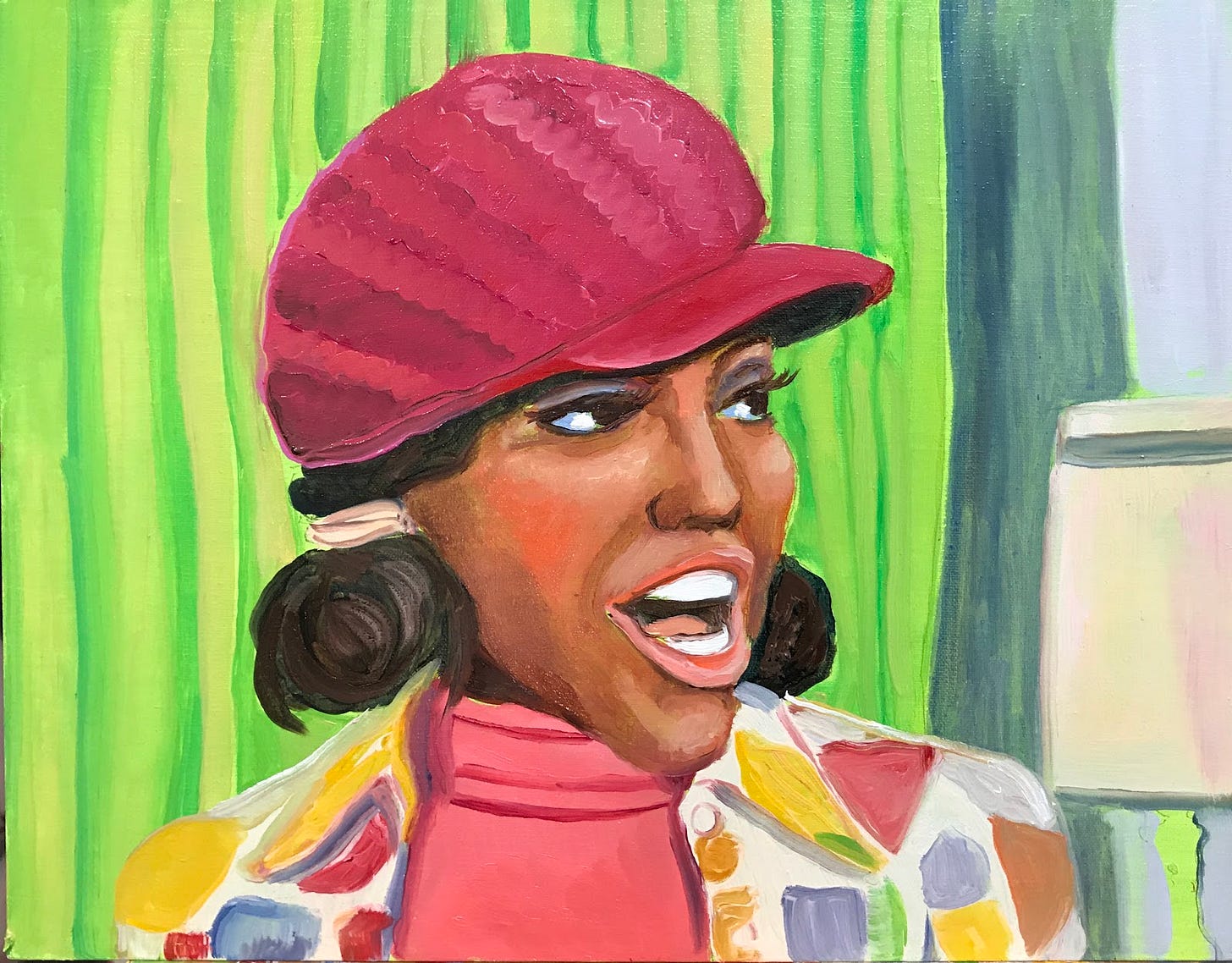

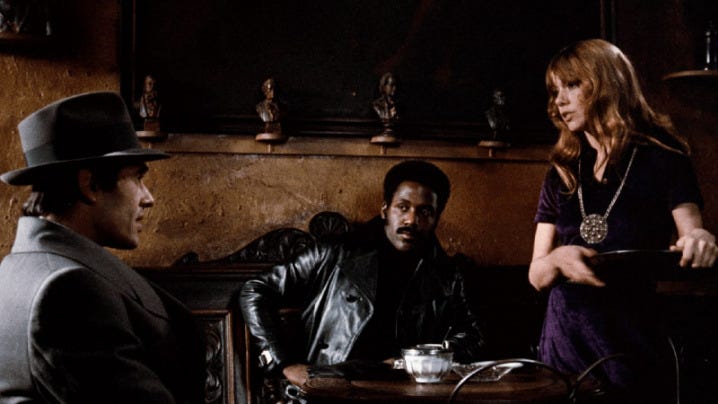

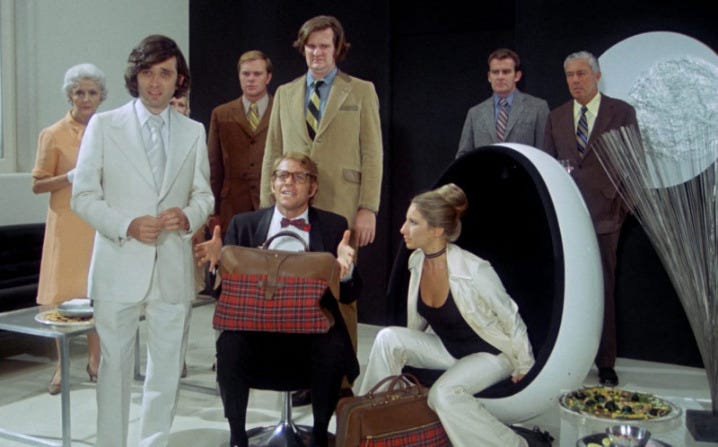

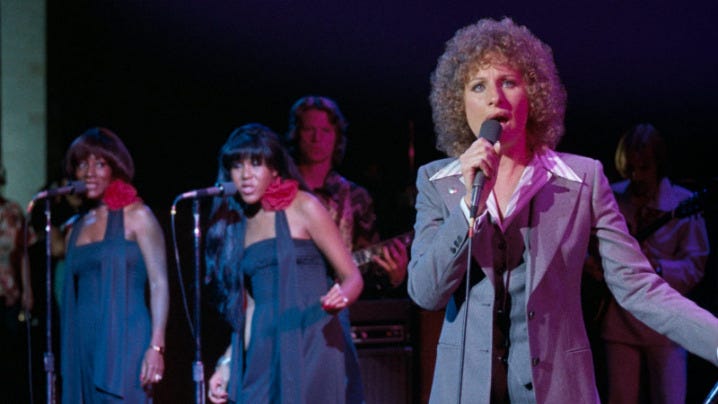


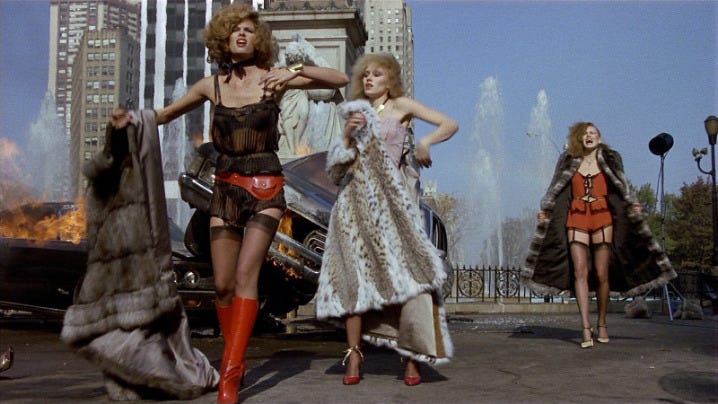





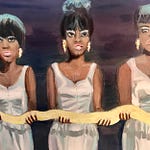


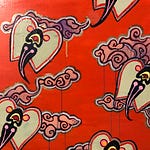
Share this post